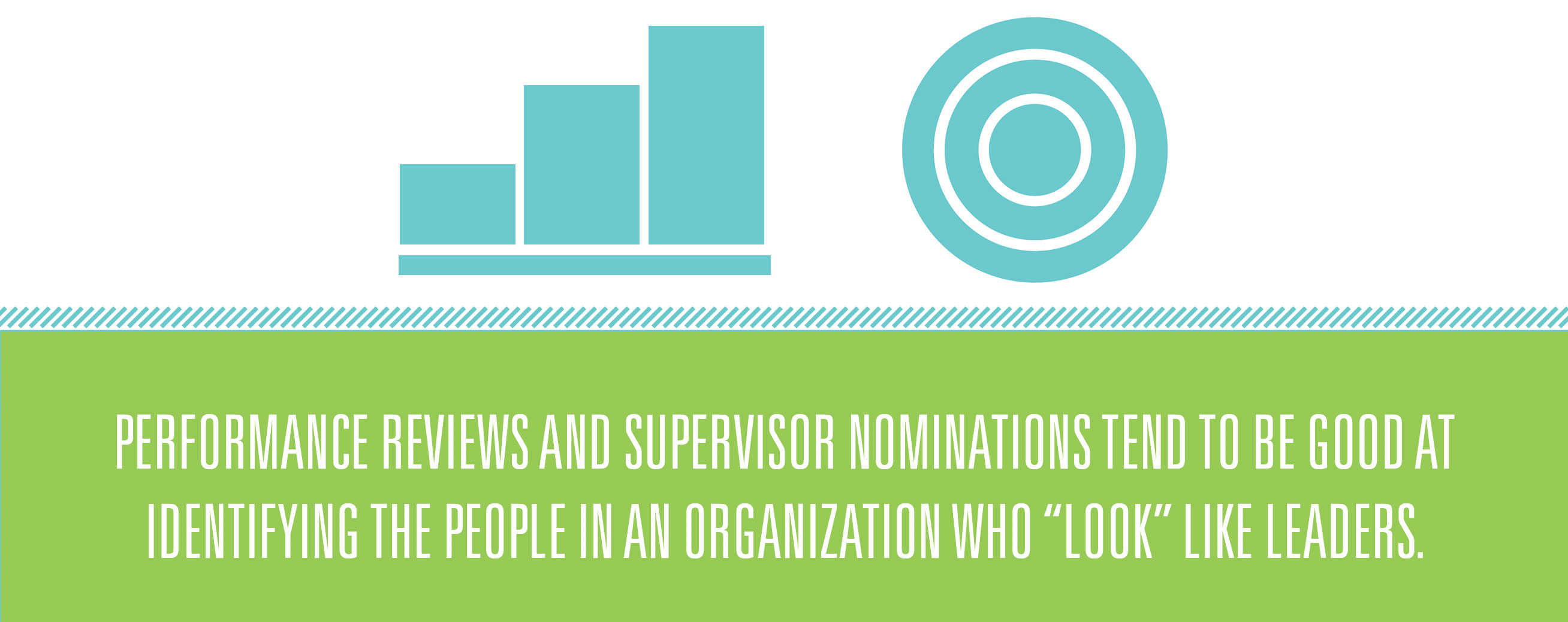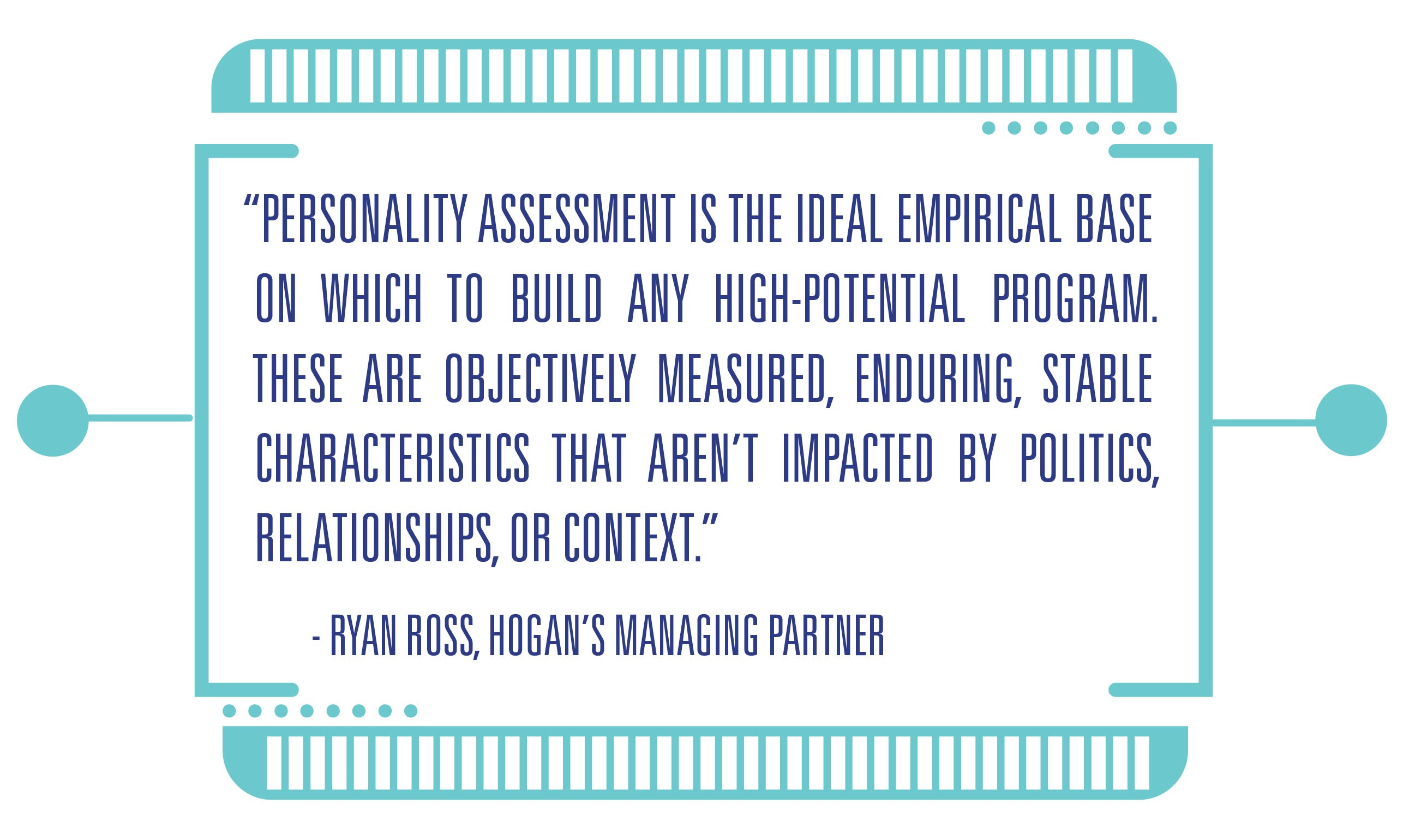
The Politics of Potential
How organizational politics are poking holes in your high potential program
By Hogan
LEADERSHIP MATTERS.
Studies show organizations with strong leadership are 13 times more likely to outperform their competition, and three times more likely to retain their most talented employees. CEO personality alone can account for a 29% variance in profitability, which is nearly four times more than the corporation itself (8%) or its industry (6%). And research suggests that top management has a much greater impact on organizational performance than even the CEO.1
Smart organizations recognize that in order to succeed, they need to develop a steady pipeline of talented high-potential employees ready to take the leadership reins when someone gets promoted, steps down, or gets fired. The concept of succession planning and creating a leadership pipeline isn’t anything revolutionary or even new. Most companies recognize its importance, but only about one out of three companies is actually prepared.
According to a global study, only 15% of North American and Asian companies and only 30% of European companies have enough qualified successors to fill key positions. And in competitive, high-growth emerging markets, many companies are finding their leadership pipelines quickly running dry.2
Although this looming leadership crisis is unsettling, it isn’t necessarily surprising. According to a report by UNC’s Kenan-Flagler Business School, 56% of companies have a formal process to identify high-potential employees, yet 71% of respondents are unsatisfied or only moderately satisfied with the effectiveness of those processes.3 Because there are no established best practices for identifying high-potential employees, current processes are plagued by bias and politics, and produce mixed results at best.

EVEN IF A COMPANY DOES IDENTIFY THE RIGHT CANDIDATES, WHAT THEN?
Even if a company does identify the right candidates, what then? The haphazard way most organizations approach high-potential development leads to stalled careers and makes their best employees more susceptible to being poached by competitors. Studies estimate losing a high-potential employee costs the organization 3.5 times his or her annual compensation,4 not including the costs of departing institutional knowledge and productivity lost in onboarding and training time. Perhaps it’s these challenges that lead Guy Beaudin, Senior Partner of RHR international, to aptly characterize high-potential identification and development as the “Holy Grail of organizational life: mysterious, elusive, and always seemingly just around the corner.”5 That elusiveness of high potentials has real consequences. Failure rates of leadership placements are absurdly high. Many practitioners and studies estimate at least 50% of new leaders fail in a new role, costing organizations millions of dollars in talent management costs6 and running up the tab with operational mistakes. Further, the shortage of quality internal placements drives many organizations to rely on externally sourced hires to fill leadership gaps in their organizations. Unfortunately, outside hires are poor substitutes for well-developed internal candidates. A study from Florida State and Mississippi State Universities found that internally promoted CEOs bring more than 25% greater total financial performance than external hires.7 Wharton management professor Matthew Bidwell also points out that external hires get significantly lower performance evaluations for their first two years on the job compared to internal candidates promoted into similar positions.8
External hires are also typically paid 18% to 20% more, and are 61% more likely to be fired from their new jobs than internally promoted candidates. In fact, more than half of external hires will fail within their first 18 months on the job, and even the most amicable of executive departures is costly. Studies indicate that the average cost of a failed executive hire ranges from $1 million to $2.7 million.
“Outside hires face enormous obstacles,” said Hogan’s Managing Partner Ryan Ross. “They are unfamiliar with the business, its employees, its culture, and the unique internal and external challenges facing the business and its employees.”
The good news is this future leadership drought is avoidable. By building high-potential programs on a scientific foundation of validated assessments, organizations can avoid common talent management mistakes and fill their pipeline with capable leaders.

THE PROBLEM WITH PERFORMANCE REVIEWS
In a post on the Harvard Business Review, CCL Director of Global Coaching Douglas Riddle described an interaction with a leader at a large corporation: “When I asked one leader to describe candidates that were chosen for his organization’s leadership academy, he snorted — “The usual suspects. High potential is another term for good ass-kissing.9
This leader’s response reflects the prevailing attitude toward high-potential programs in the corporate world. In a survey of more than 450 organizations by AMA Enterprise, only 14% of employees regarded their company’s high-potential program as fair. 24% described their company’s high-potential program as “flawed, but well-intentioned,” and another 34% viewed it as “partial and political.”
According to the same survey, the negativity most people feel toward high-potential programs has led more than 42% of companies to avoid using the term “high potentials” entirely, especially when communicating to employees.10
One of the biggest struggles most companies face is presenting a clear definition of potential. Potential for what? High-potential programs are intended to identify individuals with leadership potential, but most often they end up mistaking current performance for leadership potential, or favoring individuals who are talented at organizational politics.
Although methods for identifying and developing high potentials have become increasingly more data-driven,11 many companies still rely on supervisor nominations and performance appraisals to identify potential in their talent pools. A survey found 74% of companies identify high potentials based on performance appraisals, and 68.5% based on recommendations from management. Of those recommendations, 55% said senior executives played the biggest role, followed by managers (52%) directors (44%), and supervisors (33%).12
THE IDEA OF LEANING ON PERFORMANCE REVIEWS IS
THAT THE BEST PREDICTOR OF FUTURE PERFORMANCE
IS PAST PERFORMANCE, THAT INFORMATION IS IMPORTANT,
BUT WITHOUT PROPER CONTEXT, NONE OF IT IS USEFUL.
First, organizations tend to overestimate current performance as a predictor of future potential. As he stated in an article on Entrepreneur, ClearCompany Co-founder Andre Lavoie points out that although all high-potential employees are high performers, not all high-performing employees are high potentials. Research shows that only 30% of current high performers are actually high-potential employees, and most employees (more than 90%) would have trouble at the next level.13
Using these methods, practitioners rate themselves as effective at identifying high potentials only about 50% of the time.5 That means many high-potential identification systems in place today could achieve the same level of accuracy of prediction by flipping a coin. That’s a costly coin toss. At the very least, wrongly designating a high performer as a high potential means you lose an excellent individual contributor. More than half of high-potential employees drop out of development programs or leave their employer within five years, and the loss of high-potential employees can add up for organizations.4
At worst, promoting the wrong people can cause major engagement problems within your organization. Leadership directly impacts employee engagement. Good leadership creates engaged employees; bad leadership leaves employees alienated and demoralized. Engaged employees are energized, proud, enthusiastic, and have positive attitudes at work. Companies with engaged employees show higher returns on assets, are more profitable, and yield nearly twice the value to their shareholders compared to companies characterized by low employee engagement. Disengagement results in an estimated $300 billion in lost productivity in the U.S. each year.14
Second, performance measures tend to be subjective and biased by politics. Performance appraisals often reflect how much supervisors like their employees, and may sometimes over-inflate ratings of actual job performance. Therefore, people designated as high performers are often actually emergent leaders, the people who are already likely to build the relationships, exert social influence, and stand out enough to get ahead. The problem is that the qualities it takes to climb the corporate ladder are not the same qualities that make a leader effective.
Most organizations have trouble discerning key differences between leader emergence and leader effectiveness.15 There are key differences between leaders who emerge as a function of political skill, interpersonal savvy, and self-promotion skills, and leaders who are effective at building high-performing organizations, cultivating talent, and leading engaged, productive teams.11
Performance reviews and supervisor nominations tend to be good at identifying the people in an organization who “look” like leaders. Emergent leaders seem smart, confident, and charismatic. They’re interpersonally savvy — talented at shaking the right hands and forming the relationships and alliances they need to advance their careers — and excellent self-promoters.
These characteristics are critical to helping individuals climb the corporate ladder. High-potential candidates without these characteristics are unlikely to ever play the game enough to get ahead. However, these characteristics aren’t enough to succeed at the top, which is why performance appraisals and supervisor nominations don’t work and why 46% of leaders fail to meet business objectives in a new role.16 Only focusing on emerging leaders can cause organizations to miss the individuals in your organization who actually have the potential to succeed as leaders.

EMERGENCE VERSUS EFFECTIVENESS

Leadership is usually defined in terms of a person’s status in an organization. People often assume that if a person has a title, he or she must have leadership skills. Human evolution suggests an alternative definition of leadership. During two million years of pre-history, humans lived in egalitarian hunter-gatherer societies, and there was constant warfare between them. Leadership evolved as a mechanism that allowed normally selfish individuals to pull together for a common purpose—to compete with neighboring groups. In these evolutionary terms, leadership should be defined as the ability to build and maintain a team that can outperform the competition.
Unfortunately, individuals who are great at building a team, driving business results, and managing their employees aren’t always great at managing up, which is why they often go unnoticed. Researchers spent a year studying 437 managers through observations, ratings, and assessments. They found that successful managers (in terms of pay increases and promotions) spend most of their time managing up by networking and politicking, whereas effective managers (those with loyal, engaged teams and strong results) spend most of their time guiding subordinates and driving team performance.
Most importantly, these two groups only overlapped about 10% of the time, which means your organization could be leaving potentially great leaders languishing in lower management positions. Even when you do manage to identify this 10%, it may not be enough.

Emergence and effectiveness are both critical components for high-potential identification, and are well-established concepts. But there is a third component, a strong foundation, that often gets overlooked.
To succeed as leaders, individuals often need to be good organizational citizens. They need to be willing to follow rules and respect convention, and they need to put the success of the organization above their own selfish goals.
“When I think of really emergent, really effective leaders with weak foundations, I think about the mortgage company and investment bank executives we’ve seen in the news testifying before Congress,” said Rebecca Callahan, manager of Hogan Lab. “They’re excellent at getting promoted, and actually great at building a cohesive team and driving results from their employees, but the way that they do that is by bending rules, pushing boundaries, or flat out breaking the law.”
Great leaders focus on their people rather than themselves, persistently doing what benefits the greater good. As Jim Collins points out, persistence is typical of emergent leaders, but humility is not. Both are characteristics of leaders who drove their companies from good to great.17
THE HOGAN HIGH POTENTIAL MODEL
The reason most high-potential programs struggle to produce results is that they’re missing one thing: science. Hogan’s model of high potential is built on 30 years of independent research and validated on more than 21,000 global managers across every industry.
We measure leadership potential as a function of personality and core values. Personality is best understood from two views: identity and reputation. Identity is how you see yourself — personality from the inside. Reputation is how others see you — personality from the outside. The problem with identity is most people are biased when it comes to to recognizing their strengths and weaknesses. We tend to overestimate how good we are at things, and to minimize our weaknesses. That makes identity a moving target, and a poor predictor of how you’re likely to perform.
Reputation, on the other hand, is stable over time, and tends to be a more accurate reflection of your strengths and weaknesses, which makes it an excellent predictor of leadership potential. After all, other people’s perceptions and opinions are what get you hired, noticed, promoted, or fired.
Hogan measures reputation along three dimensions:
- Bright-side, or day-to-day personality, which predicts how people behave when they’re under normal circumstances.
- Dark-side personality, or derailers, which predicts how people behave when they’re under the increased stress or pressure common to leadership roles, or when they simply aren’t paying attention to how they’re acting.
- Values, or the drivers, beliefs, and interests that predict what people are willing to work for and in what type of job, position, and organizational culture they are likely to feel most satisfied.
This multidimensional approach to assessment paints a comprehensive picture of each person – his or her work habits, ideal job type, leadership potential, and probable derailers – far beyond the information available in a traditional process. We identify leadership potential along three dimensions and nine competencies:


FOUNDATIONS
Managing one’s career, being rewarding to deal with, and being a good organizational citizen
FOLLOWING PROCESS:
following rules and respecting convention
THINKING BROADLY:
solving a wide range of business-related problems
GETTING ALONG:
being cooperative, pleasant, and rewarding to deal with

EMERGENCE
Standing out, emerging, and being labeled as a leader
STANDING OUT:
making others aware of one’s contributions
INFLUENCING OTHERS:
persuading others to pursue certain desired outcomes
BUILDING CONNECTIONS:
creating strategic networks and relationships

EFFECTIVENESS
Successfully guiding teams toward productive outcomes
LEADING THE BUSINESS:
achieving critical business outcomes
MANAGING RESOURCES:
securing, optimizing, and deploying key assets
LEADING PEOPLE:
motivating others to pursue shared goals

ROOM TO GROW
Many organizations invest heavily in the identification of high potentials, and then approach development in a haphazard way. Some surveys show as many as 95% of organizations fail to follow-through on high-potential development plans.18
It’s rare to find a high-potential candidate prepared to step directly into top management — virtually every individual identified as having the potential for a leadership role will require some degree of development. Personality assessment provides an ideal base for building custom development plans for high-potential employees.
For most people, there is a significant gap between their identity – how they see themselves, and their reputations – how others see them. These blind spots can become crippling career derailers that undermine leaders’ authority and inhibit their ability to build high-performing teams. Validated personality assessments provide the strategic self-awareness imperative for closing that gap when developing high potentials.
“PERSONALITY ASSESSMENT AND FEEDBACK PROVIDE A CLEAR UNDERSTANDING OF YOUR STRENGTHS AND WEAKNESSES, AND HOW THOSE STRENGTHS AND WEAKNESSES COMPARE TO THOSE OF OTHERS.”
– RODNEY WARRENFELTZ,
HOGAN’S MANAGING PARTNER

THE BOTTOM LINE
Leadership matters, and developing a high-potential program that provides a steady pipeline of talented employees who are ready to lead is critical to guaranteeing your organization’s future success. But the old ways of identifying and developing high-potential employees isn’t working, and many companies are facing a talent management crisis as a result.
Hogan High Potential Talent Report harnesses the powerful science of personality to help you identify potential across three dimensions and nine competencies proven to predict leadership success and provides a strong base on which to build a development program. To learn more about Hogan’s High Potential Report, visit HOGANHIPO.COM.
1 Mackey, A. (2008). The effect of CEOs on firm performance. Strategic Management Journal, 29(12), 1357-1367. doi: 10.1002/smj.708
2 Fernández-Aráoz, C., Groysberg, B., & Nohria, N. (2011). How to hang on to your high potentials. Harvard Business Review, 89(10), 76-83.
3 UNC Kenan-Flagler (2013). UNC leadership survey 2013: High-potential leadership. Retrieved from http://www.kenan-flagler.unc.edu/~/media/Files/documents/executive-development/unc-leadership-survey-2013-HiPo.pdf?la=en
4 Chatterjee, A. (2015, Nov. 24). The curious case of the leaking high potential boat. Retrieved from http://www.right.com/wps/wcm/connect/right-us-en/home/thoughtwire/categories/talent-work/the-curious-case-of-the-leaking-high-potential-boat
5 Chamorro-Premuzic, T., & Pillans, G. (2016, Feb. 28). Assessing Potential. Retrieved from https://issuu.com/crforum/docs/03_-_assessing_potential_e832bd602b2b49
6 Hogan Assessment Systems. (2012, December). Off the Rails: Avoiding the High Cost of Failed Leadership. Retrieved from http://www.mtmcoach.com/wp-content/uploads/OFF-THE-RAILS-Avoiding-the-High-Cost-of-Leadership.pdf
7 Ang, J. S., & Nagel, G. L. (2009). Outside and inside hired CEOs: A performance surprise. SSRN Electronic Journal. doi: 10.2139/ssrn.1501024
8 University of Pennsylvania. (2012, March). Why External Hires Get Paid More, and Perform Worse, than Internal Staff. Retrieved from the University of Pennsylvania website http://knowledge.wharton.upenn.edu/article/why-external-hires-get-paid-more-and-perform-worse-than-internal-staff/
9 Riddle, D. (2012, July). Your high-potential program could ruin your business. Harvard Business Review. Retrieved from https://hbr.org/2012/07/your-high-potential-program
10 Starner, T. (2013, November). ‘High-Potential’ term losing luster. Human Resource Executive Online. Retrieved from http://www.hreonline.com/HRE/view/story.jhtml?id=534356376
11 Hogan, R., & Kaiser, R. B. (2005). What we know about leadership. Review of General Psychology, 9(2), 169-180.
12 Babcock, P. (2012, April). Selection criteria for high-potentials vary widely. Society for Human Resource Management. Retrieved from https://www.shrm.org/resourcesandtools/hr-topics/talent-acquisition/pages/selectioncriteriaforhighpotentials.aspx
1
3 Lavoie, A. (2015, July). High performers and high-potential employees are not one in the same. Entrepreneur. Retrieved from https://www.entrepreneur.com/article/248018
14 Gallup. (2001, March). What Your Disaffected Workers Cost. Gallup Business Journal. Retrieved from http://www.gallup.com/businessjournal/439/what-your-disaffected-workers-cost.aspx
15 Luthans, F. (1988). Successful vs. effective real managers. The Academy of Management EXECUTIVE, 2(2), 127-132.
16 Smith, M. M. (2014, May). Why your HiPo program may be a waste of time and money. Retrieved from https://www.eremedia.com/tlnt/why-your-hipo-program-may-be-a-waste-of-time-and-money/
17 Collins, J. (2001). Good to great. New York, NY: HarperCollins Publishers Inc.
18 Martin, J. (2016, March). New Strategies for Managing High-Potential Program Success [PDF document]. Retrieved from http://www.hreonline.com/pdfs/ NewStrategiesforManagingHighPotentialProgramSuccess.pdf

